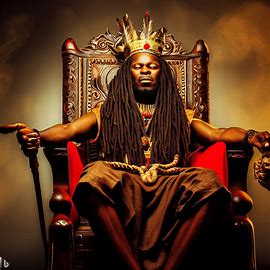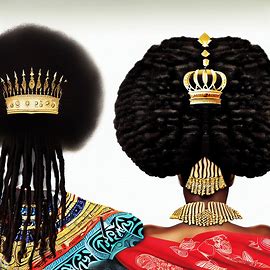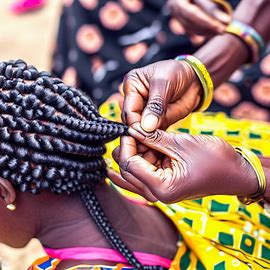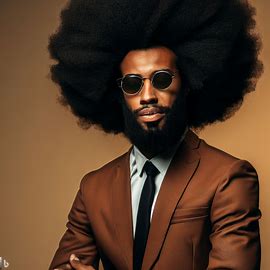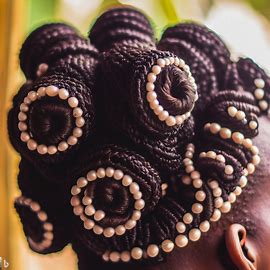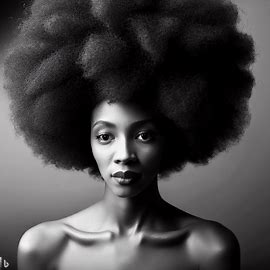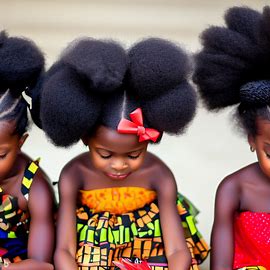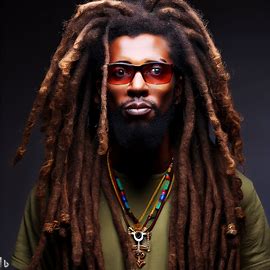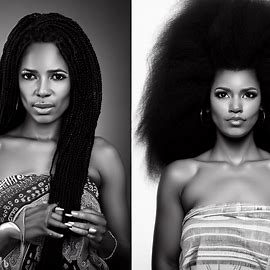“The Symbolism and Significance of Referring to Hair as the ‘Crown”
- Symbol of Royalty and Authority: Throughout history, rulers, monarchs, and other figures of authority often wore ornate and elaborate headdresses or crowns on their heads. These accessories were designed to signify their power and leadership. By extension, hair, which naturally crowns the head, is seen as a symbol of one’s personal sovereignty and uniqueness.
- Visual Prominence: Hair is one of the most visually prominent features on a person’s head and contributes significantly to their overall appearance. Just as a crown atop a ruler’s head draws attention and signifies their status, well-groomed or styled hair can have a similar effect in terms of personal presentation.
- Cultural Significance: In many cultures around the world, hair has held cultural, spiritual, or ritualistic importance. Hairstyles and haircare practices have been used to express cultural identity, social status, and personal beliefs. By calling it the “crown,” we acknowledge the cultural and symbolic significance of hair.
- Self-Expression: Hair can be a form of self-expression, allowing individuals to showcase their creativity, personality, and individuality. By referring to it as the “crown,” we highlight the role it plays in how people express themselves and how they are perceived by others.
- Influence on Confidence: For many people, the way their hair looks can greatly influence their confidence and self-esteem. When hair looks good, individuals often feel more self-assured, akin to the way someone might feel more regal when wearing a crown.
In summary, calling hair the “crown” is a metaphorical and symbolic way to recognize its significance in personal identity, appearance, and cultural expression. It underscores the idea that hair is not just a physical attribute but a part of how individuals present themselves and the role it plays in their self-confidence and self-image.
“Rooted in Beauty: A Historical Journey Through African Hairstyles”
The history of Black hairstyles is a rich and diverse tapestry that reflects the cultural, social, and political evolution of African and African-descendant communities. These hairstyles are more than just aesthetics; they are a form of self-expression, cultural identity, and resistance. Here’s an overview of the history of Black hairstyles, from ancient Africa to the present day:
1.Ancient Africa: In Africa, hairstyles have been a significant part of various cultures for thousands of years. Different tribes and regions had distinct hairstyles that often conveyed social status, age, marital status, and tribal affiliation. Cornrows, braids, twists, and intricate patterns were common.
- Transatlantic Slave Trade: During the transatlantic slave trade, Africans brought their diverse hair traditions with them to the Americas. However, enslaved individuals were often forced to adopt European hairstyles to devalue their African identity.
- Post-Emancipation: After emancipation, Black individuals began to embrace and celebrate their natural hair textures. The late 19th and early 20th centuries saw the emergence of the hot comb and chemical straightening treatments, which allowed some individuals to temporarily straighten their hair.
- The Harlem Renaissance: In the 1920s and 1930s, the Harlem Renaissance marked a cultural and artistic movement among Black Americans. It also led to the popularization of the Jheri curl, finger waves, and other iconic hairstyles.
- Civil Rights Movement: During the Civil Rights Movement of the 1950s and 1960s, the Afro became a powerful symbol of Black pride, identity, and resistance. It represented a rejection of Eurocentric beauty standards and a celebration of natural Black hair.
- Black is Beautiful Movement: In the late 1960s and early 1970s, the Black is Beautiful movement promoted natural hairstyles and encouraged Black individuals to embrace their hair in its natural state. This period saw the proliferation of afros, braids, and dreadlocks.
- The 1980s and 1990s: These decades witnessed the rise of iconic Black hairstyles like box braids, cornrows, and the resurgence of dreadlocks. Hip-hop culture and music videos played a significant role in popularizing these styles.
- The Natural Hair Movement: In recent years, there has been a resurgence of interest in natural Black hair. Many individuals have chosen to embrace their natural textures, leading to the popularity of the “big chop” (cutting off chemically treated hair) and the growth of online communities and influencers dedicated to natural hair care.
- Legal and Social Advocacy: In 2019, California became the first U.S. state to pass the Crown Act, prohibiting hair discrimination in workplaces and schools. This legislation acknowledges the importance of Black hairstyles as a form of cultural expression and works to combat discrimination.
Black hairstyles continue to evolve and adapt, reflecting contemporary fashion trends, cultural influences, and personal preferences. They remain a powerful means of celebrating cultural heritage and asserting individual identity while challenging societal norms and stereotypes. These hairstyles are not only a reflection of beauty but also a testament to resilience and pride in the face of historical adversity.
“Unraveling a History of Hair Discrimination and Celebrating Black Beauty”
For centuries, racist grooming policies and beauty standards have upheld European features and hair textures as the epitome of beauty, while stigmatizing the natural beauty of Black hair. From the days of slavery to the era of Jim Crow laws, these discriminatory practices persisted, leaving a deep-seated impact on Black individuals’ self-esteem and identity.
The Black Power movement of the 1960s and 1970s marked a turning point. It boldly proclaimed that afros, braids, and other natural hairstyles were not just fashion choices but powerful symbols of Black beauty, culture, and empowerment. Yet, despite this cultural revolution, mainstream society continued to label these hairstyles as “unprofessional.”
Decades later, schools and workplaces across the United States maintained these discriminatory norms. Black students and employees found themselves disciplined, suspended, or even fired for wearing natural hairstyles like locs or braids. The injustice reached a critical point in 2018 when a high school wrestler in New Jersey was forced to choose between cutting off his locs or forfeiting a match. The incident went viral, sparking nationwide outrage and highlighting the urgent need for change.
Around the same time, the natural hair movement experienced a resurgence, with increasing numbers of Black men and women proudly embracing their natural styles. Despite this cultural shift, the deeply ingrained stigma and discrimination endured.
In 2019, California became the trailblazer, passing the CROWN Act, thanks to the tireless efforts of Senator Holly Mitchell. The CROWN Act, which stands for “Creating a Respectful and Open World for Natural Hair,” aimed to dismantle hair discrimination at the state level. This landmark legislation sent a powerful message that Black hair should be celebrated, not condemned.
Following California’s lead, several states, including New York, New Jersey, Maryland, Colorado, and Washington, passed their own CROWN Act laws. These victories signified a growing recognition of the importance of protecting Black individuals from hair discrimination.
In 2020, Senator Cory Booker introduced the CROWN Act in Congress, seeking to ban hair discrimination on a national level. While the bill successfully passed in the House of Representatives, it has yet to secure Senate approval, underscoring the ongoing challenges in the fight against hair discrimination.
Today, the CROWN Act movement continues to gain momentum, with bills introduced in over 20 states. Grassroots organizations like Dove’s CROWN Coalition have played a vital role in raising awareness and mobilizing support for this crucial cause. With each passing day, the CROWN Act brings us closer to a more inclusive and equitable society where every individual can proudly wear their hair as a symbol of their identity, culture, and beauty.
“From Roots to Runways: A Journey Through the History of African Hairstyles”
Many African and African American hairstyles have been shaped and popularized by a variety of individuals and communities over time. While it’s challenging to pinpoint specific creators for some styles due to their long-standing presence in African and African American culture, here are some key figures and moments associated with the popularization of certain hairstyles:
- Cornrows and Braids:
- Creator: Cornrows and braids have been worn by African communities for centuries, and it is challenging to attribute them to a single creator. They are traditional styles passed down through generations.
- Publicization: These styles have been popularized by countless individuals in African and African American communities. Celebrities like Bo Derek and, more recently, artists like Beyoncé have brought attention to braids and cornrows in the mainstream media.
- Afros:
- Creator: The Afro is not attributed to a single creator, as it was a collective symbol of Black pride and identity during the Civil Rights Movement.
- Publicization: The Afro became a powerful symbol of Black pride during the Civil Rights Movement in the 1960s. Public figures like Angela Davis, Huey Newton, and Pam Grier, among others, played a significant role in popularizing the style.
- Bantu Knots:
- Creator: Bantu knots originate from African ethnic groups like the Zulu and Xhosa, and they have been worn for generations.
- Publicization: The style gained global attention when celebrities like Rihanna, Alicia Keys, and Solange Knowles started wearing Bantu knots on red carpets and in music videos.
- Locs (Dreadlocks):
- Creator: Dreadlocks have been worn by various cultures throughout history. They have roots in Rastafarianism, an Afro-Jamaican religious and cultural movement.
- Publicization: Musician Bob Marley, a prominent Rastafarian, played a significant role in popularizing dreadlocks. Later, artists like Lauryn Hill and Whoopi Goldberg helped destigmatize the style in the mainstream.
- Hair Extensions and Weaves:
- Creator: The use of hair extensions and weaves dates back centuries in African and African American history, with origins in Africa.
- Publicization: Celebrities like Diana Ross and Josephine Baker popularized wigs and weaves in the entertainment industry. In recent years, the trend has been championed by artists like Nicki Minaj and Cardi B.
- Natural Hair Movement:
- Creator: The natural hair movement is a collective effort by individuals who decided to embrace their natural hair textures.
- Publicization: Social media and online communities have played a significant role in promoting natural hair. Early influencers like Taren Guy and Naptural85 paved the way for many others to share their natural hair journeys.
It’s important to recognize that these hairstyles have deep cultural and historical roots within African and African American communities, making it difficult to attribute their creation to specific individuals. Instead, they are part of a rich and diverse cultural heritage that continues to evolve and thrive.
“Dismantling Discrimination: The Vital Importance of the CROWN Act”
In the ongoing fight for equality, one critical front is the battle against discrimination based on race, particularly against Black individuals. While strides have been made in various aspects of life, racial discrimination persists, often manifesting itself in subtle but damaging ways. The Crown Act is a significant step in addressing one such issue – hair discrimination.
The Crown Act Explained
The Crown Act, or Creating a Respectful and Open World for Natural Hair, is a legislative initiative aimed at combating discrimination based on natural hair texture and protective hairstyles, primarily targeting people of African descent. The Act seeks to amend existing laws and policies to ensure that traits commonly associated with certain racial or ethnic backgrounds, such as natural hair textures, are not grounds for discrimination in workplaces, schools, or public accommodations.
Historical Context
Hair discrimination has deep roots in history, often being used as a tool to subjugate and control Black individuals. Throughout the centuries, Eurocentric beauty standards have perpetuated the idea that straight hair is more professional and acceptable than natural Afro-textured hair. As a result, Black individuals have faced discrimination and prejudice based on their hair, including being denied job opportunities or forced to conform to unnatural grooming standards.
Key Provisions of the Crown Act
- Protection Against Discrimination: The Crown Act explicitly prohibits discrimination in employment, education, and public spaces based on natural hair or protective hairstyles such as braids, locs, twists, and afros.
- Expansion of Civil Rights Legislation: By including hair texture and protective hairstyles as protected characteristics, the Crown Act builds on the Civil Rights Act of 1964, which outlawed discrimination on the basis of race, color, religion, sex, or national origin.
- Education and Awareness: The Act encourages educational institutions and employers to conduct training programs and workshops to raise awareness about hair discrimination and promote inclusive and diverse environments.
- Legal Recourse: Victims of hair discrimination can seek legal remedies, including filing complaints with relevant authorities, pursuing civil litigation, or reporting incidents to human rights commissions.
Impact of the Crown Act
- Promoting Self-Expression: The Crown Act empowers individuals to express their natural identity and cultural heritage without fear of discrimination. It encourages self-confidence and self-acceptance.
- Economic Empowerment: By reducing barriers to employment and educational opportunities, the Act contributes to economic empowerment within the Black community, ultimately helping to close socio-economic gaps.
- Educational Equality: The Crown Act ensures that students are not subject to discriminatory policies or practices related to their hair, promoting equal access to education.
- Social Change: The Act fosters a broader conversation about racism and bias, challenging stereotypes and prejudices that persist in society.
Challenges and Ongoing Efforts
While the Crown Act represents a significant step forward in the fight against hair discrimination, challenges remain. Implementation and enforcement of the Act can be uneven, and there is a need for continued education and advocacy to change deeply ingrained perceptions and attitudes about natural hair. Additionally, ensuring that the Act is adopted at the federal level across the United States is an ongoing goal.
Conclusion
The Crown Act is a vital piece of legislation that addresses a form of discrimination that has persisted for far too long. By acknowledging and protecting natural hair textures and protective hairstyles, it promotes equality, self-expression, and cultural pride. However, its effectiveness depends on ongoing efforts to raise awareness, educate, and challenge societal norms that perpetuate hair discrimination. The Crown Act reminds us that the fight for equality is multifaceted, and every step toward a more inclusive society is a step in the right direction.
Matter of Opinion
The CROWN Act stands for “Creating a Respectful and Open World for Natural Hair.” It is a law that prohibits race-based hair discrimination, which is the denial of employment and educational opportunities because of hair texture or protective hairstyles such as braids, locs, twists or bantu knots.
The CROWN Act was first introduced in 2019 by California State Senator Holly Mitchell and has since been passed in over 20 states. It aims to combat long-held societal norms that have deemed black hairstyles “unprofessional” in educational institutions and workplaces. For example, many schools and companies have policies banning natural black hairstyles or have sent black students and employees home for wearing locs, afros, braids, etc.
Supporters of the CROWN Act say that hair discrimination targets black individuals and impacts educational and career opportunities. They argue that hairstyles are an important part of racial, ethnic, and cultural identities and should not affect professional opportunities.
Opponents argue that such legislation interferes with workplace/school grooming policies. However, advocates of the Act point out that hairstyle policies targeting hairstyles common among black people are discriminatory as they do not take into account the texture of black hair.
The CROWN Act movement hopes that banning hair discrimination can be another step toward racial justice and equality. Passing this legislation demonstrates a commitment to inclusive environments that accept individuals as they are.
We at NuOrigins are very interested in if you agree that laws need to be enacted that regulate hair expresion? What are your thoughts?


